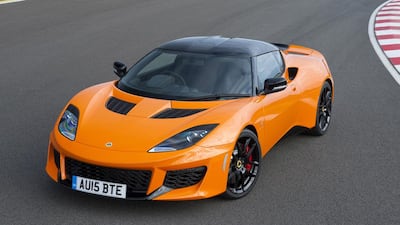Hethel, Norfolk, England; Lotus. Something of an annual rite of passage, as Lotus updates, tweaks or adds something to its line-up. It’s a difficult place to get to, located in the east of the United Kingdom. Now the A11 is a dual-carriageway, it’s less so, removing some of the penance that used to define the journey. That used to characterise the products that rolled out of Lotus’s Hethel factory: difficult to get to, but worth the effort.
We’re here to drive the new Evora 400, which, true to form, has been revised, technically as well as visually, promising greater performance and heightened thrills. There’s a charge-cooled supercharger bolted onto the 3.5L, V6 engine; revised gear linkage, new suspension and tyres and a sharper, more aggressively styled front and rear.
Obvious as those changes are, the biggest difference is what’s missing. Mirroring how the awkwardness of getting to Hethel has been reduced, so too has the difficulty of getting into the products Lotus makes. Anyone who has ever tried pouring themselves into anything wearing a Lotus badge since the Elise will appreciate the difficulty involved – it takes practice, flexibility and determination. If you’re even marginally “big-boned”, getting into a Lotus with any semblance of dignity is a testing, body-folding act of skilful contortion. I count myself as so built, yet I’m sitting in the latest Evora 400 checking out the new interior before it strikes me that getting in was entirely unremarkable.
Forget for a moment the other changes to the Evora, as the simple act of easing ingress has immediately improved it. Thank a drop in the sill height and a reduction in its width. The numbers say 56 millimetres and 43mm respectively, but they add up to a huge difference to the Evora. No longer something you’d put in the garage for occasional use, now it’s a car you might consider using every day. For Lotus to survive and prosper it needs more sales, and the only way it’ll achieve that is by getting more people into its cars.
The revolution starts here, then. Jean-Marc Gales, the chief executive officer, says the Exige will soon feature similar modifications to its structure to improve access. Given the rest of the package is so enduringly appealing, that’s a very good thing indeed. The Evora has matured in 400 form into a far more appealing prospect. The engine’s power swells to 400hp – hence the name – while every facet of its make-up has been revised to ensure it’s better able to cope with that increased output. The styling is sharper, the more aggressively formed front and rear helping improve airflow around, under and through the car, the Evora losing its somewhat amorphous face and rump in the process. The result is more cohesive, the bolder look far more dramatic – and appealing – as a result.
The interior has been similarly revised. The centre console and instrumentation are new, the materials improved. It’s still some way off the interior of a Porsche, thanks to some obviously old Ford-derived parts-bin shopping, but it’s still a marked improvement. New Sparco seats remove some weight – overall, Lotus managed to drop 42 kilograms from the Evora’s mass, despite having added around 20kg for the additional engine plumbing. Even so, the Evora 400 weighs 1,395kg, which is just 50kg shy of a Porsche 911 Carrera 2, though it retains the deftness of touch and fine control that have long been a Lotus signature.
The increase in power brings more speed, obviously, but it’s not the raw 4.2 seconds it takes to reach 100kph that’s significant, it’s the engine’s improved muscularity throughout the entire rev range. There’s joy to be had wringing it out to its redline, especially if you’ve pressed the button that liberates more sound from the exhaust, and the Evora 400 is a quick car by any measure. It’s the way it’ll maintain its speed that’s so appealing.
The chassis is beautifully set up, the electronic stability and traction systems giving you either a subtle helping hand or leaving you entirely on your own, depending on your chosen setting. The suspension rides with real composure despite its tight control and obvious focus, and there’s masses of grip and traction. The steering remains a highlight, the Evora’s rack retaining hydraulic as opposed to electrical assistance, and the results are tangible. There’s detail and texture at the wheel’s rim, the immediacy of response and the feel it delivers worth the asking price alone.
If there are any quibbles, they centre on the gearshift. It’s improved, undoubtedly, but still lacking the sort of speed and accuracy of the best three-pedal, manual set-ups. There’s an automatic option, too, and while it doesn’t offer the outright speed of the best dual-clutch rivals, it’s not so bad as to dismiss it. That’s true of the Evora 400 in its entirety, once a car that could quickly be dismissed; that’s not so easy now. The great bits remain, the compromises significantly less obvious. Not least, you can now get in with ease, and, nowadays, you’ll not want to get out.
motoring@thenational.ae
Follow us @LifeNationalUAE
Follow us on Facebook for discussions, entertainment, reviews, wellness and news.

